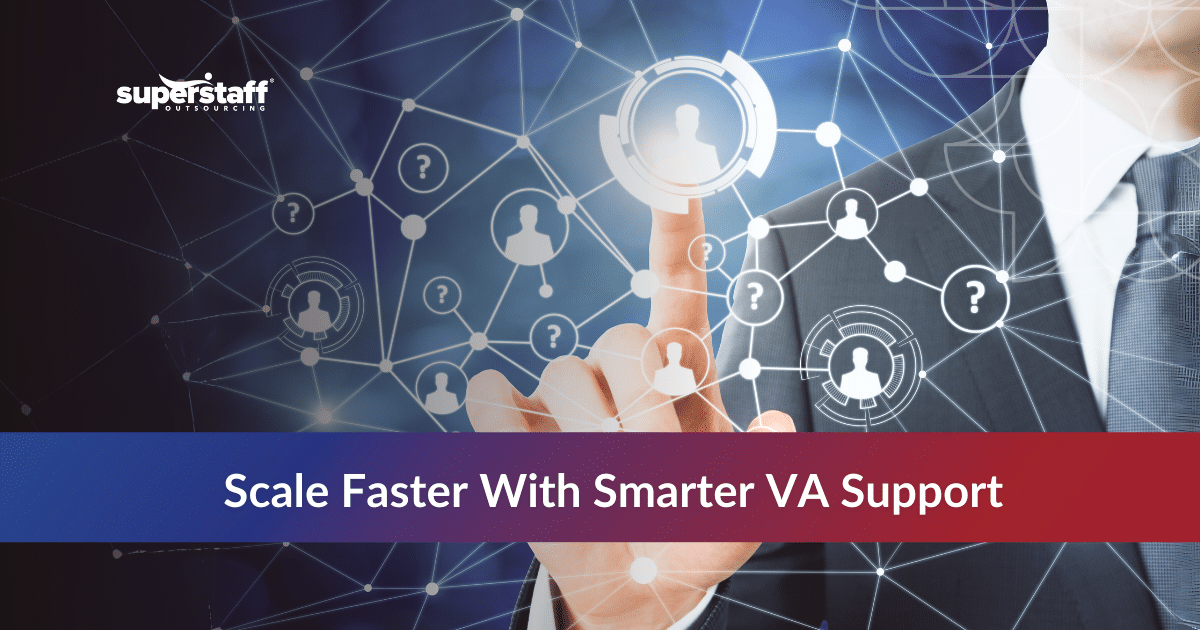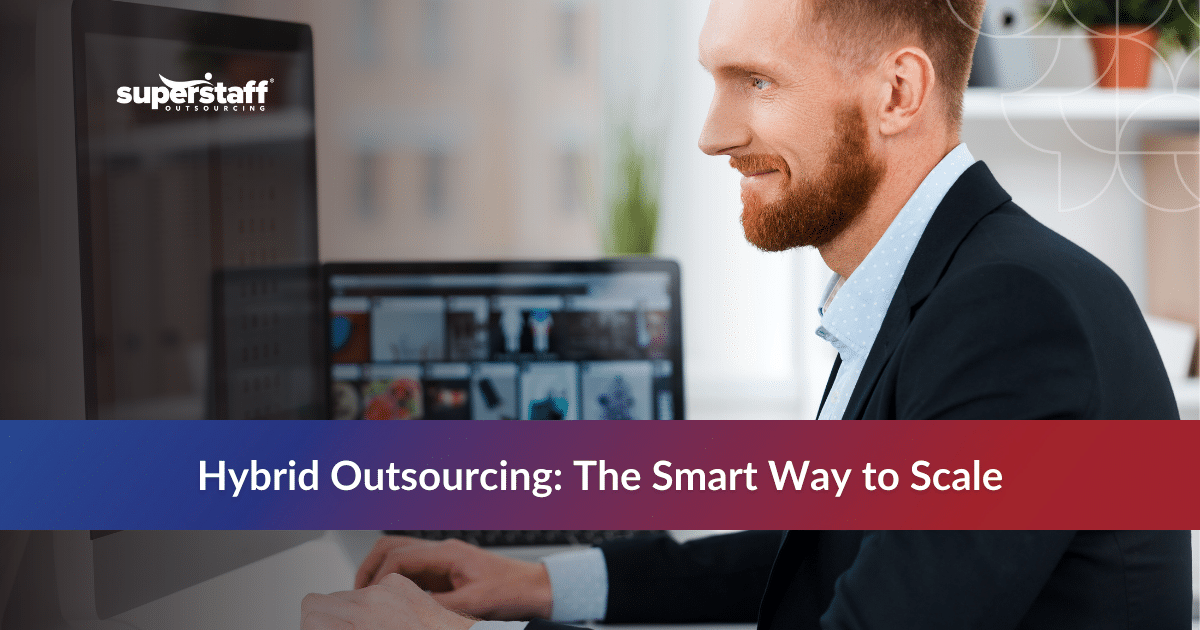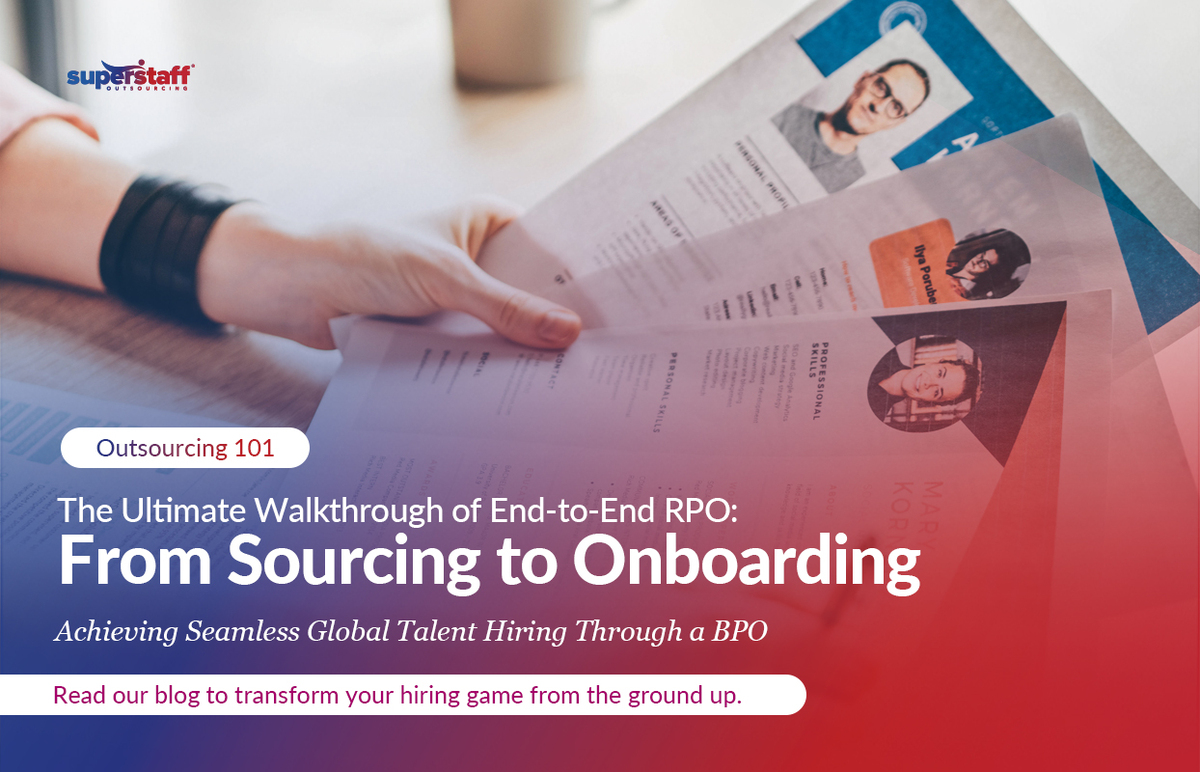
As labor shortages grip the U.S. and other Western markets, businesses are facing a familiar struggle: finding top talent while optimizing hiring processes. But what if the solution isn’t local? Global talent hubs like the Philippines and Colombia are brimming with highly skilled professionals ready to meet your recruitment needs.
In a world flooded with endless job ads and underqualified candidates, End-to-End Recruitment Process Outsourcing (RPO) offers a smarter, more efficient way to build your dream team. This guide takes you through the entire RPO journey — from sourcing to onboarding — showing you how RPO can accelerate hiring, lower costs, and connect you with top-tier talent.
A Glimpse Into End-to-End RPO: Streamlining Recruitment from Sourcing to Onboarding
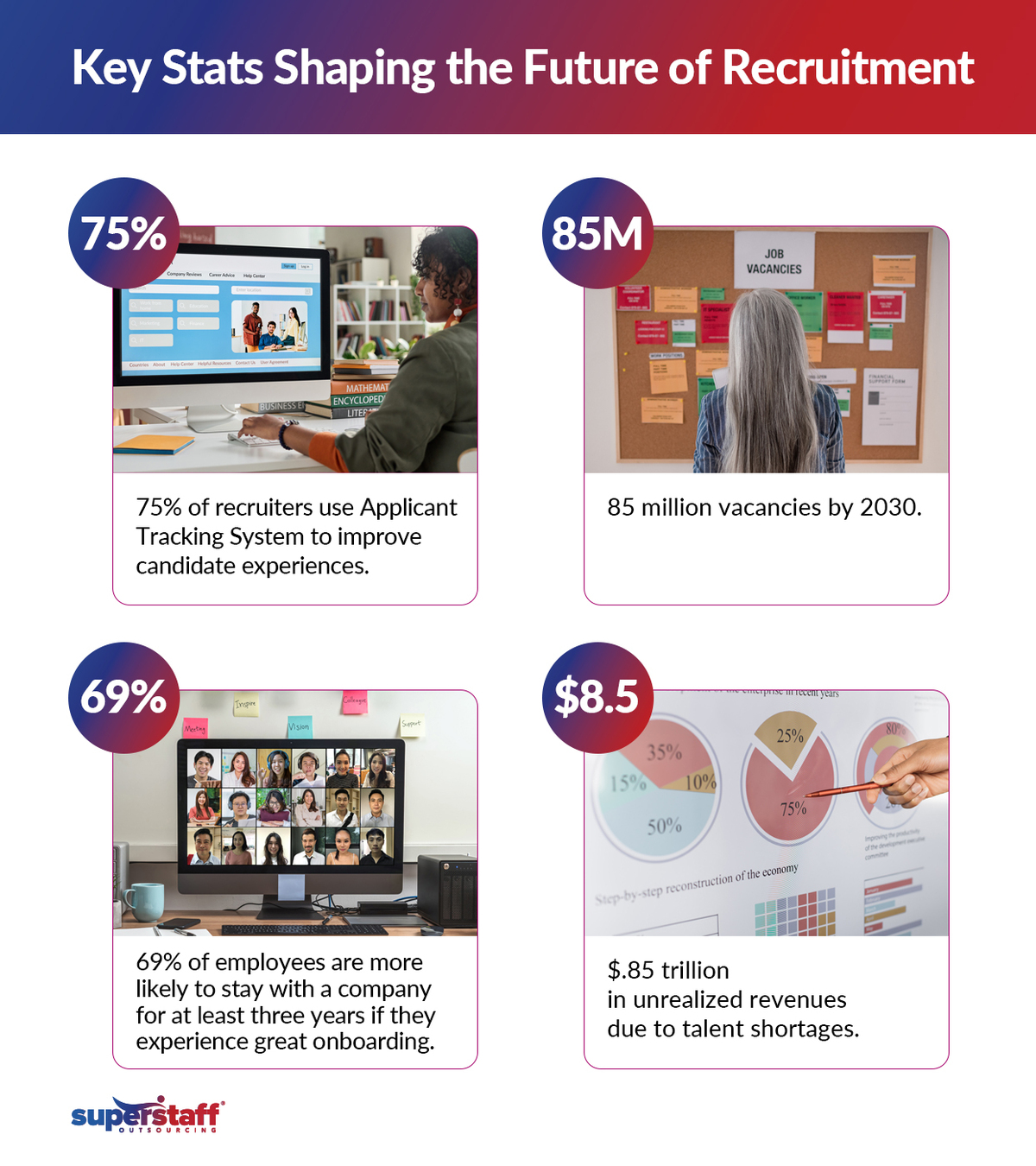
What Is Recruitment Process Outsourcing?
From the operative term “end-to-end,” it’s a full-spectrum solution that covers the entire recruitment cycle. What sets End-to-End RPO apart from partial Recruitment Process Outsourcing services or project-based services is that it doesn’t just focus on specific areas. It manages the journey as a whole, from sourcing to onboarding, offering a seamless experience for candidates and employers.
Going beyond simply filling positions, it integrates strategy, technology, and expertise to ensure that your organization not only attracts but retains top talent. By encompassing all recruitment activities, End-to-End RPO relieves businesses of unnecessary administrative and operational burdens associated with hiring, making it a scalable and flexible solution for organizations of all sizes.
The Full Recruitment Cycle
End-to-end RPO is precisely what it sounds like — a solution covering every recruitment aspect. It begins with talent sourcing, where recruiters actively search for candidates who align with your company’s needs. Once potential candidates are identified, the process moves through screening, interviews, and assessments, ensuring that only the best fits are selected. Finally, the onboarding stage prepares new hires to transition smoothly into their roles, enhancing their productivity from day one.
Benefits of Full-Cycle RPO
Here’s a quick rundown of the advantages of End-to-End RPO in today’s fast-paced business landscape.
- Cost Efficiency: By outsourcing the entire recruitment process, companies can reduce the costs associated with in-house hiring teams, recruitment advertising, and time lost in inefficient hiring.
- Streamlined Processes: With a dedicated RPO provider handling every aspect, businesses benefit from a cohesive, well-managed recruitment strategy that minimizes delays and gaps in the hiring process.
- Access to a Wider Talent Pool: RPO providers often have access to broader networks and specialized talent pools that may not be available through traditional recruitment channels, helping you secure candidates with the needed skills.
- Expertise from Recruitment Professionals: RPO specialists bring industry-specific knowledge, recruitment expertise, and advanced tools to ensure a more effective hiring process, especially for hard-to-fill positions.
Cases for End-to-End RPO
While any business can benefit from a full-cycle recruitment solution, certain industries and business types stand to gain the most from it.
- Tech Startups: These companies often need to scale quickly while ensuring they hire top-tier talent. End-to-End RPO provides a flexible and rapid response to evolving hiring needs.
- Healthcare: In a sector where staffing shortages can impact patient care, RPO offers a reliable solution for quickly finding skilled professionals.
- Global Corporations: Large organizations expanding into new markets or launching high-volume recruitment drives benefit from End-to-End RPO providers’ extensive reach and expertise.
Breaking Down the Key Stages of End-to-End RPO
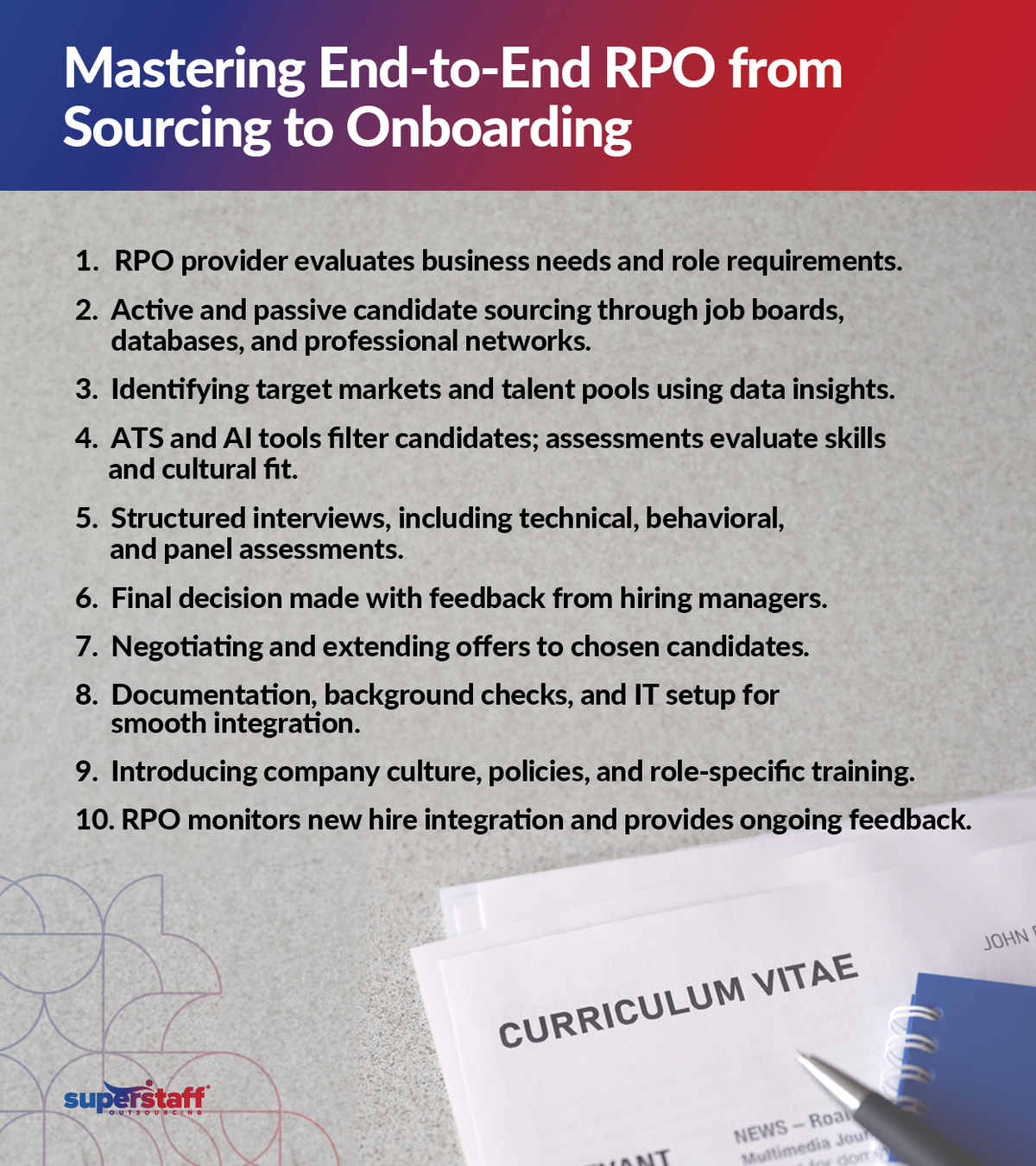
Now that you understand End-to-End RPO meaning and its businesses let’s explore its key stages to see how it operates in real-world recruitment scenarios. Each stage is tailored to address different aspects of hiring, ensuring a holistic approach to talent acquisition. It optimizes efficiency and lets you focus on what truly matters — growing your business with the right team.
Stage 1: Sourcing — Building the Talent Pipeline
Effective sourcing has never been more crucial in a looming global talent shortage. According to Korn Ferry, there could be 85 million vacancies by 2030 due to a lack of skilled people, potentially leading to $8.5 trillion in unrealized annual revenues. With such staggering numbers on the horizon, businesses must build solid sourcing pipelines to stay competitive.
Sourcing goes beyond simply filling positions — it involves identifying the right talent for long-term success. Companies can target candidates using data-driven strategies at the right time, ensuring a consistent flow of top talent that meets immediate needs and future growth objectives.
Talent Mapping
Talent mapping is the secret weapon that turns data into opportunity. In today’s competitive hiring landscape, knowing where to find suitable candidates is just as important as knowing who to hire. With intelligent data insights, RPO providers can pinpoint where the strongest candidates are and fine-tune recruitment strategies to match real-world market dynamics.
Why is this so crucial? The global labor market is far from balanced. Economies like Russia, China, and the United States are heading for severe talent shortages. Japan, Indonesia, and Brazil face even steeper challenges, each staring down shortages of up to 18 million skilled workers. But while some regions are struggling, others offer untapped potential. For example, the Philippines, with a workforce of over 50 million, presents a goldmine of talent waiting to be harnessed.
By leveraging talent mapping, companies can stay ahead of the curve—navigating global talent shortages and identifying the markets where the best opportunities lie. This approach transforms recruitment from a reactive process to a proactive strategy, allowing businesses to target the right people in the right places at the right time.
Active Sourcing
In active sourcing, RPO specialists search job boards, LinkedIn, and other professional platforms to find candidates who fit the job description directly. This method allows recruiters to connect with professionals who meet the company’s criteria rather than waiting for applications. By actively pursuing talent, businesses can fill roles quickly and with higher-quality hires.
Passive Candidate Engagement
Another game-changing aspect of sourcing is engaging passive candidates — those talented professionals who aren’t actively job hunting but are a perfect fit for your role. These hidden gems might not be scrolling through job boards, but they can be persuaded to explore new opportunities with the right approach. That’s where RPO providers come in, using smart, targeted outreach and recruitment marketing strategies to capture their attention and pique their interest. Tapping into the passive candidate pool opens the door to high-quality talent that often slips through traditional hiring methods.
The kicker is that how you approach them makes all the difference. Job seekers, whether active or passive, can sense a company’s culture and professionalism based on the tone of your job descriptions. In fact, 75% of candidates respond better to job descriptions that use broader language rather than overly casual or formal tones. If your job postings are overloaded with emojis, and hashtags, or come off too casual, candidates might assume your company lacks seriousness. Conversely, if your descriptions are stiff and full of jargon or buzzwords, you risk scaring off talent with an intimidating or overly corporate vibe.
The sweet spot? Strike a balance. Be professional but personable. Clear, friendly, and informative descriptions are crucial to making your company approachable and credible, drawing in the right candidates with the right message.
Roles Involved in the Sourcing Process
- RPO Sourcing Specialists: These experts are dedicated to finding the right candidates through various tools and databases, ensuring a constant flow of talent.
- Recruitment Marketing Experts: Tasked with crafting targeted campaigns, these specialists ensure that employer branding and job opportunities reach the most relevant audiences, attracting top-tier talent.
Once the talent pool is identified, the next crucial step is screening to ensure that candidates meet the qualifications and are the right fit for the organization.
Stage 2: Screening – Filtering for the Best Fit
With your candidate pool already locked in, screening is the next pivotal step in the End-to-End RPO process. Think of this stage as the ultimate gatekeeping, meticulously filtering through applicants to ensure that only those who fit the bill advance in the recruitment journey. A well-structured screening process isn’t just necessary; it’s essential for maintaining high hiring standards while saving precious time and resources.
Resume Screening with ATS and AI
Speed and efficiency are everything in today’s fast-paced hiring landscape. Applicant Tracking Systems (ATS) and AI-driven tools revolutionize how recruiters filter through resumes. These advanced systems automatically scan and filter applications based on pre-set keywords, qualifications, and job requirements. Instead of manually reviewing hundreds of resumes, recruiters can instantly identify the top candidates who best match the role.
And it’s not just about saving time — about 75% of recruiters now use ATS or similar tech-driven tools to streamline the review process and enhance the candidate experience. By automating the initial screening, these tools minimize human error and ensure that only the most qualified applicants make it to the next stage. This means hiring teams can focus on connecting with the right talent faster and more confidently.
Pre-Employment Assessments
Resumes only scratch the surface. You need pre-employment assessments — powerful tools that delve into candidates’ technical skills, cognitive abilities, and cultural fit. These standardized tests provide a comprehensive snapshot of a candidate’s potential, illuminating aspects of their suitability for the role that might not shine through on paper. By incorporating these assessments early in the hiring process, businesses can confidently identify which candidates deserve a closer look, paving the way for smarter hiring decisions.
Pre-Screening Interviews
Before diving into more extensive interviews, short pre-screening interviews serve as an essential checkpoint in the recruitment journey. During these brief conversations, employers can verify critical details like a candidate’s experience, availability, and genuine interest in the role. This step is a win-win: it ensures candidates meet the basic qualifications while saving valuable time for both parties. By establishing alignment from the very start, companies can streamline the hiring process and focus on candidates who are ready to shine.
Roles Involved in the Screening Process
- RPO Screening Coordinators: These professionals manage the resume filtering process and conduct initial assessments to ensure only qualified candidates are passed on for further evaluation.
- RPO Talent Assessors: Experts in evaluating technical skills and cultural fit, talent assessors design and administer customized assessments that help gauge a candidate’s potential for success.
After the screening process narrows down the candidate pool, the next step is the interviewing stage, where the goal is to assess the candidates’ abilities and how well they align with the company’s culture and long-term vision.
Stage 3: Interviewing – Evaluating for Skill and Cultural Fit
Once the initial screening is complete, interviews take center stage. They allow one to explore a candidate’s skills, experience, and alignment with your company’s values more deeply. This crucial phase will enable businesses to assess whether candidates meet technical requirements and embody the right cultural fit.
Compelling interviews do more than just tick boxes; they prevent costly mis-hires and ensure new team members are positioned for long-term success. Almost half (45%) of candidates abandon job opportunities due to negative experiences during the interview process. By conducting structured interviews, organizations can foster a positive experience that leaves candidates feeling valued and engaged.
When done right, interviews empower businesses to make informed, strategic hiring decisions that address immediate needs while paving the way for future growth. Ultimately, it’s not just about filling a role; it’s about cultivating a thriving team that drives success.
Technical Interviews
Technical interviews are where the rubber meets the road when hiring for specialized roles. This crucial phase dives deep into the specific skills required for the job, ensuring candidates can handle the technical demands they’ll face. Whether it’s coding a complex algorithm, crafting a stunning design, or solving intricate problems, these interviews provide a window into a candidate’s ability to perform essential tasks. It gauges what they know and how well they can apply that knowledge in real-world scenarios.
Behavioral Interviews
Shifting gears, behavioral interviews focus on the past to forecast the future. By delving into candidates’ experiences, interviewers uncover how they’ve navigated challenges, collaborated in teams, and exhibited leadership qualities. These insights are invaluable for assessing a candidate’s soft skills and cultural fit within the organization. It’s a chance to see how they’ve handled various situations and understand their teamwork and problem-solving approach — which is critical for success in any role.
Panel Interviews
Adding another layer to the evaluation process, panel interviews gather diverse stakeholders — department heads, HR representatives, and team leads — into one room (or virtual space). This collaborative format allows for a multifaceted assessment of candidates, blending different perspectives on technical abilities and interpersonal skills. Each panelist contributes unique insights, which enriches the evaluation and minimizes the risk of bias. This ensures that the best candidate is chosen, one who aligns seamlessly with the role and the team culture.
Roles Involved in the Interviewing Process
- RPO Interview Coordinators: These professionals handle all logistics, including scheduling, preparing interview materials, and coordinating communication between candidates and the company.
- RPO Hiring Consultants: Responsible for conducting interviews and providing feedback to hiring managers based on the candidate’s performance.
- Subject Matter Experts (SMEs): Brought in to offer technical insight during evaluations, ensuring that candidates have the specific expertise required for the role.
After interviews wrap up and a candidate is chosen, all attention shifts to onboarding — an essential phase that bridges the gap between recruitment and full integration into the company. This pivotal stage lays the groundwork for a successful and fulfilling employee experience, ensuring new hires feel supported and equipped to thrive. A seamless onboarding process sets the tone for productivity, engagement, and long-term retention, making it a key component of any effective recruitment strategy.
Stage 4: Onboarding – Ensuring a Smooth Transition and Long-Term Success
The final stage of the End-to-End RPO process is onboarding. It’s where the real magic happens — transforming fresh hires into engaged, loyal, and productive team members. A well-designed onboarding experience does far more than just check administrative boxes. It creates a lasting impact, reducing turnover, boosting job satisfaction, and fast-tracking productivity.
Most (69%) employees are likelier to stay with a company for three years if they experience great onboarding.
Document Collection and Background Checks
The onboarding journey kicks off with essential administrative tasks like document collection and background checks. This isn’t just a formality — it’s a crucial step to ensure all legal and employment paperwork is in order before the new hire starts. By taking care of everything from tax forms to employment contracts upfront, organizations protect themselves from potential legal issues and give new employees peace of mind, letting them focus on their new role.
Training and Orientation
With the paperwork squared away, the spotlight shifts to training and orientation. This is where new hires are set up for success. By walking them through company processes, policies, and culture and equipping them with the technical skills they need, organizations ensure their people feel confident, capable, and supported. It’s not just about getting to know the job — practical orientation aligns employees with the company’s values and goals, driving engagement from day one.
IT and Administrative Setup
A seamless IT and administrative setup is the backbone of a successful onboarding experience. Ensuring that new hires have access to all the right tools — from email accounts to project management systems — not only keeps things running smoothly but also empowers employees to hit the ground running. By eliminating delays in access to technology and equipment, Recruitment Process Outsourcing companies pave the way for immediate productivity, helping new hires make an impact from the start.
Roles Involved in the Onboarding Process
- RPO Onboarding Specialists: These professionals manage the paperwork, ensuring that all compliance requirements are met and that the onboarding process flows smoothly.
- RPO Training Specialists: Responsible for facilitating orientation and training programs, these specialists ensure that new hires understand their roles and how to succeed within the company.
Once onboarding is complete, the focus naturally shifts to continuous improvement — a critical phase that ensures your recruitment process never stagnates. Through detailed reporting and data analysis, businesses can fine-tune their strategies, making sure future hires are an even better fit for organizational needs and goals.
Stage 5: Reporting and Continuous Improvement – Using Data to Optimize Recruitment
The final stage of the End-to-End RPO process is all about reporting and continuous improvement—a crucial phase where insights turn into action. By harnessing data-driven analysis, companies can fine-tune their recruitment strategies, monitor progress, and continually optimize their hiring efforts. This step ensures that every move aligns with long-term business goals, driving efficiency and securing better hires.
Reporting doesn’t just offer a window into your recruitment team’s performance. It arms you with the real-time data needed to make smarter, faster decisions.
KPI Reports
One of the key tools in this stage is KPI (Key Performance Indicator) reporting. These reports shed light on core metrics like time-to-hire, cost-per-hire, and quality-of-hire — each providing a clear view of how well the hiring process is running. Time-to-hire shows how quickly roles are filled, while cost-per-hire evaluates financial efficiency. Quality-of-hire, perhaps the most telling, tracks how well new employees perform once they’re onboarded. By digging into these metrics, businesses can pinpoint bottlenecks, trim costs, and make sure the right talent is coming through the door.
Candidate Feedback
Ever wonder what candidates really think about your hiring process? Candidate feedback is a goldmine of information.
Whether they get the job or not, candidates can provide valuable insights that help improve the recruitment journey. Listening to their feedback can refine how you engage candidates, streamline your process, and ensure fewer drop-offs. Happy candidates, even those who don’t get hired, become brand advocates — making this feedback loop a critical piece of your long-term recruitment strategy.
Diversity and Inclusion Metrics
Diversity and inclusion are must-haves in today’s landscape. Tracking diversity and inclusion metrics helps measure your true progress. By seeing how well you attract diverse talent, you can ensure your efforts are performative and genuinely impactful. Accountability is key here, as these metrics show whether your hiring practices align with your diversity commitment.
In today’s competitive landscape, 67% of candidates seek a more empathetic tone in DEI. Generic platitudes won’t cut it anymore — candidates want to feel that diversity is a core value, not just an afterthought. When your DEI statements radiate empathy and back it up with real action, it resonate. It sets your company apart in a crowded marketplace, making candidates more likely to choose you over competitors. By showcasing your authentic commitment to diversity, you invite candidates to join a culture where they feel they belong.
Let your commitment to diversity speak volumes — through empathetic language and tangible results—setting your company apart in a crowded marketplace. When candidates feel your organization values inclusivity, they’re more likely to join you in that mission.
Roles Involved in Reporting and Continuous Improvement
- RPO Data Analysts: These professionals gather and analyze recruitment data, providing valuable insights that inform decision-making and optimization efforts.
- RPO Account Managers: Account managers oversee the recruitment process and provide strategic advice based on collected data. They ensure that the recruitment process aligns with business objectives and help adjust strategies for continual improvement.
With every stage of the End-to-End RPO process expertly managed, it’s clear that this comprehensive approach does more than just streamline recruitment — it transforms it. By optimizing every step, businesses can consistently secure top-tier talent faster and with greater precision. What sets this process apart is the integration of real-time reporting and continuous improvement, ensuring your recruitment strategies are always evolving.
The Strategic Solution for End-to-End RPO
Gain a strategic edge with faster, more cost-efficient hiring processes that elevate your team and drive long-term success. SuperStaff offers a seamless, end-to-end solution that handles every stage of recruitment — from sourcing top talent to onboarding, all while leveraging cutting-edge technology and global expertise.
What makes SuperStaff your ideal RPO partner? It’s our commitment to tailoring recruitment solutions to fit your business. Beyond filling roles, we build relationships, offering data-driven insights to improve hiring outcomes continuously. Whether you’re scaling up quickly or refining the quality of your hires, we ensure your recruitment is always aligned with your growth objectives.
Partner with us to transform hiring from a logistical challenge into a strategic advantage!


